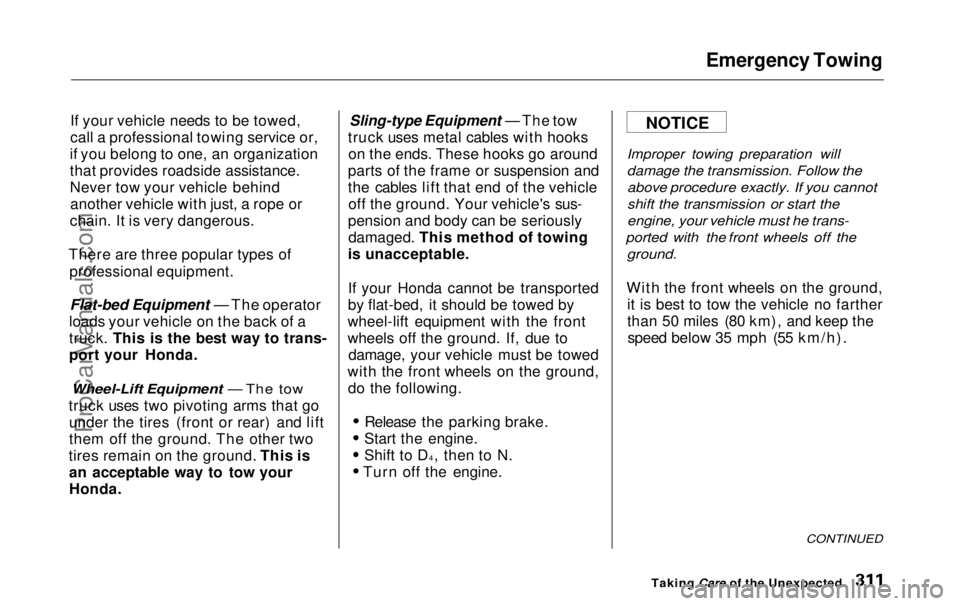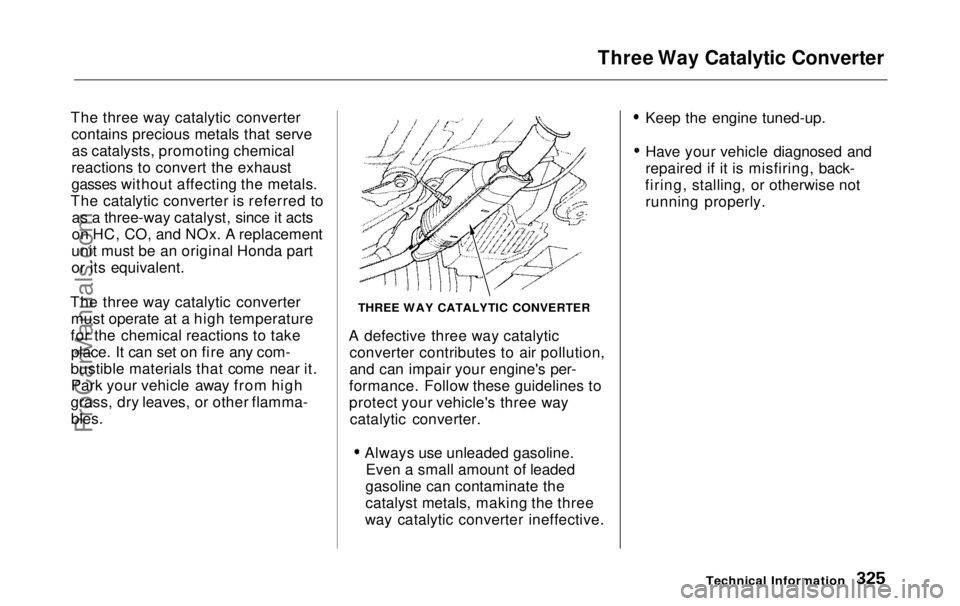Page 310 of 343

Emergency Towing
If your vehicle needs to be towed,
call a professional towing service or,
if you belong to one, an organization
that provides roadside assistance.
Never tow your vehicle behind another vehicle with just, a rope or
chain. It is very dangerous.
There are three popular types of professional equipment.
Flat-bed Equipment — The operator
loads your vehicle on the back of a
truck. This is the best way to trans-
port your Honda.
Wheel-Lift Equipment — The tow
truck uses two pivoting arms that go under the tires (front or rear) and lift
them off the ground. The other two
tires remain on the ground. This is an acceptable way to tow your
Honda.
Sling-type Equipment — The tow
truck uses metal cables with hooks on the ends. These hooks go around
parts of the frame or suspension and
the cables lift that end of the vehicle off the ground. Your vehicle's sus-
pension and body can be seriously damaged. This method of towing
is unacceptable.
If your Honda cannot be transported
by flat-bed, it should be towed by
wheel-lift equipment with the front
wheels off the ground. If, due to damage, your vehicle must be towed
with the front wheels on the ground, do the following.
Release the parking brake.
Start the engine.
Shift to D 4, then to N.
Turn off the engine.
Improper towing preparation will
damage the transmission. Follow the
above procedure exactly. If you cannot
shift the transmission or start the
engine, your vehicle must he trans-
ported with the front wheels off the
ground.
With the front wheels on the ground, it is best to tow the vehicle no farther
than 50 miles (80 km), and keep thespeed below 35 mph (55 km/h).
CONTINUED
Taking Care of the Unexpected
NOTICEProCarManuals.comMain Menu Table of Contents s t
Page 313 of 343
Identification Numbers
Your vehicle has several identifying numbers located in various places.
The Vehicle Identification Number (VIN) is the 17-digit number your
Honda dealer uses to register your
vehicle for warranty purposes. It is also necessary for licensing and
insuring your vehicle. The easiest
place to find the VIN is on a plate
fastened to the top of the dashboard.
You can see it by looking through the windshield on the driver's side. Itis also on the Certification label at-
tached to the driver's doorjamb, and
is stamped on the engine com-
partment bulkhead. The VIN is also
provided in bar code on the Certification label. VEHICLE IDENTIFICATION NUMBER
CERTIFICATION LABEL
Technical InformationProCarManuals.comMain Menu Table of Contents s t
Page 314 of 343
Identification Numbers
The Engine Number is stamped into the engine block. It is on the front.
The Transmission Number is on a label on top of the transmission.
Technical Information
ENGINE NUMBER
AUTOMATIC TRANSMISSION NUMBERProCarManuals.comMain Menu Table of Contents s t
Page 315 of 343
Specifications
*
1 : Including the coolant in the reserve tank and that remaining in the
engine.
Reserve tan
k capacity:
0.16 US gal (0.6 ,0.13 Imp gal)
*
2 : Excluding the oil remaining in the engine.
Technical Information
*
1
: LX
*2
:
EX
ProCarManuals.comMain Menu Table of Contents s t
Page 322 of 343

Emissions Controls
The burning of gasoline in your
vehicle's engine produces several by- products. Some of these are carbonmonoxide (CO), oxides of nitrogen (NOx) and hydrocarbons (HC).
Gasoline evaporating from the tank
also produces hydrocarbons. Con-
trolling the production of NOx, CO, and HC is important to the environ-
ment. Under certain conditions of sunlight and climate, NOx and HC
react to form photochemical "smog." Carbon monoxide does not contri-
bute to smog creation, but it is a
poisonous gas. The Clean Air Act
The United States Clean Air Act*
sets standards for automobile
emissions. It also requires that
automobile manufacturers explain to
owners how their emissions controls
work and what to do to maintain them. This section summarizes how
the emissions controls work.Scheduled maintenance is on page 224.
* In Canada, Honda vehicles comply
with the Canadian Motor Vehicle Safety Standards (CMVSS) for
Emissions valid at the time they are
manufactured. Crankcase Emissions Control
System
Your vehicle has a Positive Crankcase Ventilation System. This
keeps gasses that build up in the engine's crankcase from going into
the atmosphere. The Positive Crank- case Ventilation valve routes them
from the crankcase back to the intake manifold. They are then
drawn into the engine and burned.
Evaporative Emissions Control
System
As gasoline evaporates in the fuel tank, an evaporative emissionscontrol canister filled with charcoal
adsorbs the vapor. It is stored in thiscanister while the engine is off. After
the engine is started and warmed up,
the vapor is drawn into the engine and burned during driving.
Technical InformationProCarManuals.comMain Menu Table of Contents s t
Page 323 of 343

Emissions Controls
Exhaust Emissions Controls
The exhaust emissions controls include four systems: PGM-FI,Ignition Timing Control, ExhaustGas Recirculation and Three Way
Catalytic Converter. These four
systems work together to control the
engine's combustion and minimize
the amount of HC, CO, and NOx that comes out the tailpipe. The exhaust
emissions control systems areseparate from the crankcase and
evaporative emissions control
systems.
PGM-FI System
The PGM-FI System uses sequential multiport fuel injection.
It has three subsystems: Air Intake,Engine Control, and Fuel Control.
The Powertrain Control Module (PCM) uses various sensors to
determine how much air is going
into the engine. It then controls how
much fuel to inject under all operat-
ing conditions. Ignition Timing Control System
This system constantly adjusts the ignition timing, reducing the amountof HC, CO and NOx produced.
Exhaust Gas Recirculation (EGR) System
The Exhaust Gas Recirculation (EGR) system takes some of the
exhaust gas and routes it back into
the intake manifold. Adding exhaust gas to the air/fuel mixture reduces
the amount of NOx produced when
the fuel is burned.
Three Way Catalytic Converter
The three way catalytic converter is in the exhaust system. Through
chemical reactions, it converts HC,CO, and NOx in the engine's exhaust
to carbon dioxide (CO2), dinitrogen (N 2), and water vapor. Replacement Parts
The emissions control systems are designed and certified to work to-
gether in reducing emissions to
levels that comply with the Clean Air
Act. To make sure the emissions remain low, you should use only new Genuine Honda replacement parts or
their equivalent for repairs. Using
lower quality parts may increase the emissions from your vehicle.
The emissions control systems are covered by warranties separate from
the rest of your vehicle. Read your
warranty manual for more informa- tion.
Technical InformationProCarManuals.comMain Menu Table of Contents s t
Page 324 of 343

Three Way Catalytic Converter
The three way catalytic converter contains precious metals that serveas catalysts, promoting chemical
reactions to convert the exhaust
gasses without affecting the metals.
The catalytic converter is referred to as a three-way catalyst, since it acts
on HC, CO, and NOx. A replacement
unit must be an original Honda part
or its equivalent.
The three way catalytic converter must operate at a high temperature
for the chemical reactions to take place. It can set on fire any com-
bustible materials that come near it. Park your vehicle away from high
grass, dry leaves, or other flamma-
bles.
A defective three way catalytic
converter contributes to air pollution,
and can impair your engine's per-
formance. Follow these guidelines to
protect your vehicle's three way catalytic converter.
Always use unleaded gasoline.Even a small amount of leaded
gasoline can contaminate the
catalyst metals, making the three
way catalytic converter ineffective. Keep the engine tuned-up.
Have your vehicle diagnosed and
repaired if it is misfiring, back-
firing, stalling, or otherwise not running properly.
Technical Information
THREE WAY CATALYTIC CONVERTERProCarManuals.comMain Menu Table of Contents s t
Page 332 of 343
Authorized Manuals
These Publications cannot be returned for credit without receiving advance authorization within 14days of delivery. On returns, a restocking fee may be applied against the original order. P.O. BOX 07280 DETROIT, MICHIGAN 48207 1-800-782-4356 Service Manual:
This manual covers maintenance and recommended procedures for repair to engine and chassis components.It is written for the Journeyman mechanic, but is simpleenough for most mechanically-inclined owners to under-
stand.
Electrical Troubleshooting Manual:
This manual complements the Service Manual by providing in-depth troubleshooting information for each
electrical circuit in your vehicle.
Body Repair Manual:
This manual describes the procedures involved in the replacement of damaged body parts.ProCarManuals.comMain Menu Table of Contents s t